Joe McElroy got into his Honda sedan one morning in late 2020, turned the key, and heard a loud screech. “Gotdamn,” he said. As a mechanic, he knew instantly that his car’s catalytic converter — a football-sized device on the undercarriage between the engine and muffler that reduces environmentally harmful exhaust emissions — had been stolen, sawed off overnight while the car sat in the driveway. Replacing the missing part set him back $900. McElroy, who is 74 and has lived in Sacramento all his life, had never suffered this sort of theft before.
It’s an experience that has become more common across the country, especially in California, where property crime has increased since the start of the pandemic, contributing to recall campaigns that ousted the district attorney in San Francisco and aimed to do the same in Los Angeles. While news footage of robberies at convenience stores and smash-and-grabs at luxury boutiques offered recall supporters dramatic evidence of lawlessness in the state, the crime trend that has most directly affected the highest number of residents is catalytic converter theft, an act swift, invisible, and silent until the screech of broken exhaust pipes the following morning.
McElroy’s block on Meadowgate Drive in Sacramento’s southern suburbs felt tranquil and safe, lined with cypress and palm trees that framed bungalows with two-car garages, broad driveways, and lawns yellowed from drought. He often spent his evenings sitting in a plastic chair in his garage with the door open, smoking a cigarette, watching the leaves in the breeze, rarely a pedestrian or passing car in sight.
His next-door neighbors, the Vang family, warmly welcomed him when he moved in five years ago. Brothers Tou and Andrew and their mother, Monica Moua, invited him over for barbecues in their backyard, where McElroy saw the chickens they raised and met the cousins, aunties, and uncles who often dropped by the house. When there were leftovers, Monica brought McElroy and his family heaping plates of Hmong staples — boiled meat, spicy vegetables, white rice. After Andrew learned that he and McElroy shared a passion for fishing, he’d swing by after daylong sessions on the American River to show photos of the trout and bass he’d hooked. Tou often seemed too busy with work to socialize much — “most of the time I saw him, he was going somewhere,” McElroy said — but was always friendly and sometimes paused to talk shop with his mechanic neighbor.
Automobiles were an essential component of Tou’s entrepreneurial ambitions. McElroy recalled Tou talking about starting a trucking business, before eventually creating Vang Auto Core LLC in May 2019. Registration filings described its services as “recycling used or unwanted car parts.” Andrew worked at the company too.
The family appeared to be living comfortably but not lavishly. They rented their two-story house. Their new vehicles weren’t luxury brands but Toyotas. They blended into the fabric of the neighborhood, and to McElroy, the thing that stood out most about them in his memory was the kindness they showed him.
“Nice family,” McElroy said of the Vangs. “Very good neighbors. All of ’em was cool cats.”
One afternoon in November 2021, McElroy returned home from work to find police cars all over the block. Yellow crime scene tape encircled the Vangs’ house. A tarp covered a dead body on the driveway. Asking around, McElroy learned that Andrew had fatally shot a burglar who’d broken into the house.
Then, he watched a stream of officers march through the front door with dogs and sledgehammers. From his garage, he could hear the destruction.
“Cops come over and fucked up the whole house,” he said. “Just ransacked it. Knocking the walls down. They destroyed it.”
The Vangs moved out a few days after that, swiftly and silently, without any goodbyes. It took the landlord eight months to repair the house and find a new tenant. Even after another family moved in, McElroy still had no idea what happened to his old neighbors.
“Cops come over and fucked up the whole house.”
- Joe McElroy
In fact, Tou, 31, Andrew, 27, and Monica, 51, were arrested in October 2022 and accused of being part of a nationwide theft ring that moved half a billion dollars’ worth of catalytic converters over three years. Prosecutors brought charges against 21 defendants across five states in what has emerged as the first major federal criminal case seeking to expose the vast scope of the catalytic converter black market and its role in a global supply chain that stretched from California to New Jersey and Japan.
The demand for catalytic converters traces to one of their essential components: palladium, a rare metal that has become one of the most valuable minerals in the world. From early 2016 to early 2019, the per-ounce price of palladium tripled from around $500 to $1,500, exceeding the value of gold for the first time in nearly two decades. Over the next three years, the number of catalytic converter thefts soared in the US: State Farm reported that its insurance claims for that crime rose by 400% from 2019 to 2022; the National Insurance Crime Bureau announced that its data showed a 1,215% increase; law enforcement agencies in San Francisco, Tulsa, and New York City have announced sharp surges, as have police departments in Chiba, in western Japan, and London. A single catalytic converter can contain up to 7 grams of palladium, as well as 7 grams of platinum, whose value has stood for years at around $1,000 per ounce, and 2 grams of rhodium, whose per-ounce price leaped from around $650 in 2016 to $2,500 in 2019.
The palladium boom triggered a catalytic converter rush that car owners, local legislators, and law enforcement agencies are struggling to contain, as rising living costs and stagnant wages continue to drive people into desperate circumstances without clear paths to upward mobility. Hundreds of pages of court documents reviewed by BuzzFeed News reveal that stolen catalytic converters are not simply the beginning of an underground supply chain but a link in a self-sustaining cycle: the palladium inside gets extracted and ultimately sold back to car manufacturers who need it to make more catalytic converters, which are in ever-rising demand because of these thefts.
Through a family representative, the Vangs declined interview requests for this story.
Asked how he felt to learn about the allegations against the neighbors he’d grown fond of, McElroy remained steadfast.
“I miss ’em,” he said.
A good cutter can slice the catalytic converter off a car in less than one minute. With a partner keeping an eye out for witnesses, the cutter raises the vehicle with a jack, slides into the narrow space beneath, and removes the cylindrical hunk of metal with an electric handsaw.
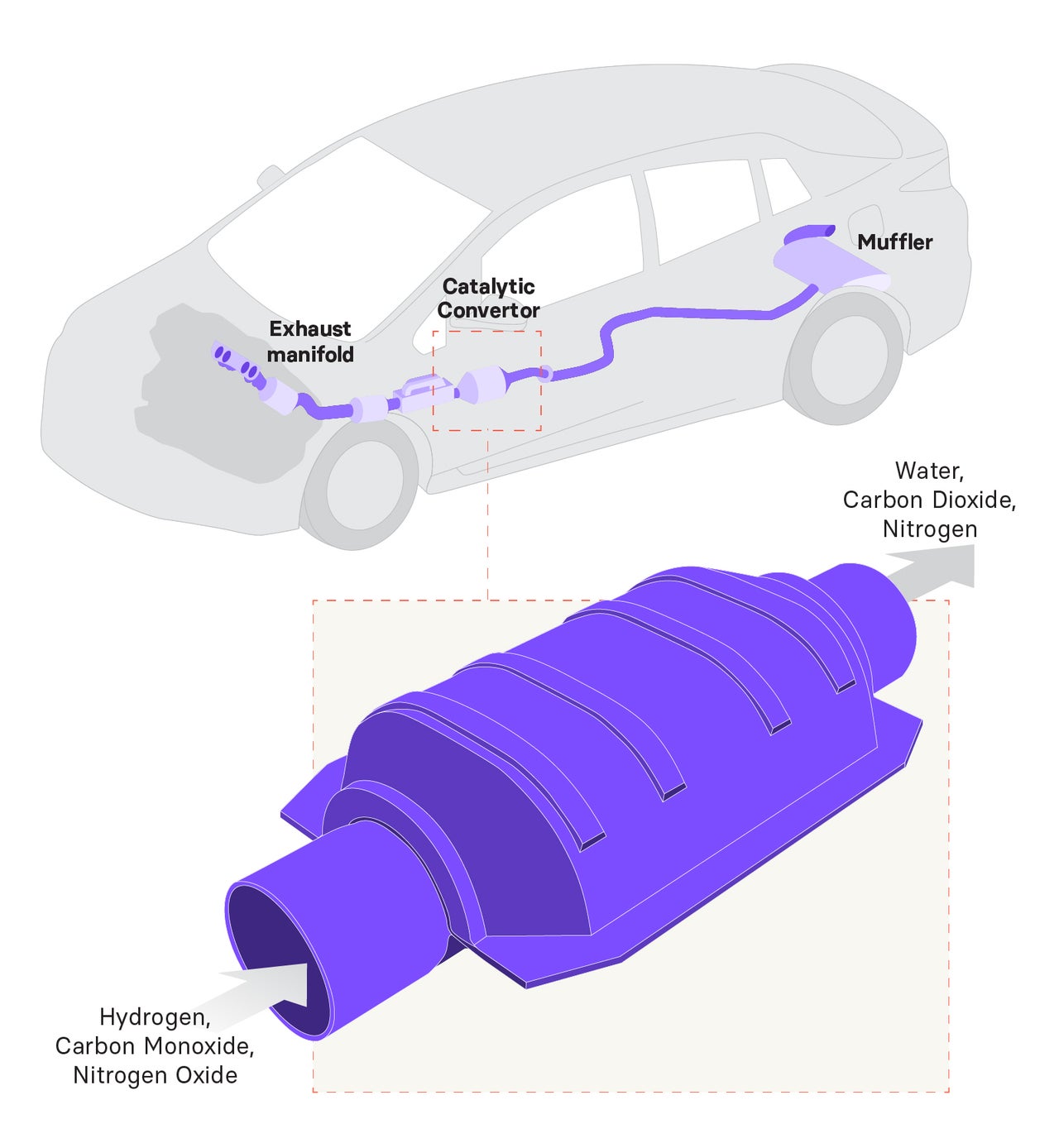
The task can be dangerous — cutters have been fatally crushed by the 3,000-pound machines they work under and killed by the people they’ve tried to steal from. But a good cutter can quickly obtain a valuable yet common product through a theft that’s not easy to catch. Since 1975, thanks to the 1970 Clean Air Act, every car in the U.S. has to have a catalytic converter. A converter can go for anywhere between $250 and $1,200 on the resale black market, depending on the type of car, and bears no official marks indicating its original owner.
“Traditionally what you’d see is people going into abandoned buildings and stripping metals from buildings to make money,” said Raymond A. Tierney, District Attorney in Suffolk County, New York. “A lot of people who are engaging in conduct like that started focusing on catalytic converters because it became more lucrative.”
“A converter can go for anywhere between $250 and $1,200 on the resale black market.”
A good cutter rarely holds on to the bounty for long. Often within 24 hours, the night’s yield is sold off to a fencer, who sells a bulk package to a recycler, who dismantles the part in order to access the precious metals. The recycler sells the metals to a metal supplier, which then sells the metals to a company that needs them to make a product, often catalytic converters.
Authorities have tried to address the theft surge by tightening regulations on the catalytic converter trade, applying the sort of oversight more common for weapons and pharmaceuticals than car parts. Since 2021, at least 12 states have passed bills requiring scrap metal dealers to keep records of catalytic converter transactions; at least 14 other states have proposed similar laws. This year, the Los Angeles City Council made it illegal for somebody to possess one without documents showing its chain of ownership. In Suffolk County, Tierney said, the problem has been so urgent that he appointed a “catalytic converter czar” to handle those specific cases.
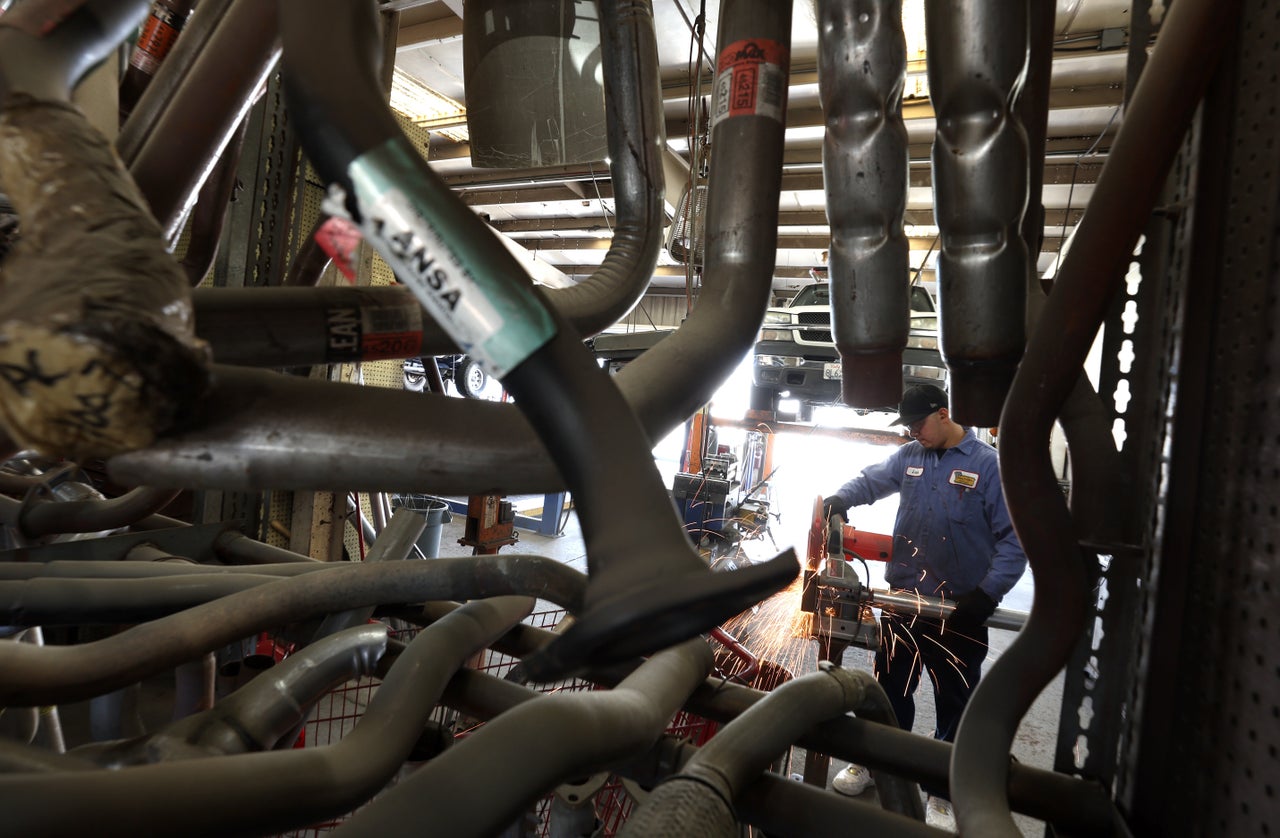
“It was being under-investigated and under-prosecuted because it hadn’t been a problem before,” Tierney said. His office has made it a practice not to offer plea bargains to suspected cutters unless they provide information on who they sell to, he said. For prosecutors to file the felony charges that build pressure on suspects to cooperate, the value of the stolen goods must be above $1,000, “but prices dip,” he said, so the office adds in the cost of the damage done to the car to ensure the alleged crime rises above a misdemeanor.
During one such investigation, when Suffolk County prosecutors traced stolen catalytic converters to an auto shop in New Jersey, they encountered federal investigators already on the trail. “They sort of asked us to stand down,” Tierney said.
As law enforcement agencies nationwide announced crackdowns on the crime and politicians proposed stricter regulations on the product, the federal investigators who spoke to Tierney were building a case that spanned from New York to California.
Catalytic converter thefts are most frequent in California, home to more than a third of all such reports in the US, according to federal prosecutors — a statistic at least partly explained by the high cost of living and the prevalence of mid-2000s Toyota Priuses, whose catalytic converters contain the highest volume of palladium. As the Los Angeles Times reported in March, the backlog for replacement converters has become very long: up to nine months for some Prius owners in the state.
“Catalytic converter thefts are most frequent in California, home to more than a third of all such reports in the U.S.”
One day in September 2020, a Prius owner in Davis, California, turned on their ignition, but a loud screech filled the air. The resident called the police. Security camera footage from another vehicle parked on the block showed a car pulling up in the middle of the night. Investigators identified the car, matched it to a name, and began surveillance. A month later, officers in Davis pulled over the car, found an undisclosed number of catalytic converters in the trunk, and arrested two men from Sacramento County, 43-year-old Dao Xiong and 37-year-old Shaneel Lal, who were ultimately convicted of conspiracy to commit grand theft and sentenced to six years in prison.
Prosecutors charged them with stealing 64 catalytic converters across eight Northern California counties, from the Bay Area to the Central Valley to the Sierra Nevada foothills. Through surveillance footage and tracking devices, investigators observed Xiong and Lal case neighborhoods during the day, before returning after dark to hit their targets. Xiong had a criminal history that stretched back two decades and included convictions for selling stolen credit cards, cashing fraudulent checks, driving a stolen car, and methamphetamine possession, according to court records.
Now, investigators identified Xiong as the first link in a global supply chain. His movements led investigators to the next link in the chain, to a house in the south Sacramento suburbs, located on Meadowgate Drive.
Raw palladium lies deep below the ground. It can be hard to locate and is typically found as a byproduct of nickel and platinum excavations, so there’s no easy way to access more of it. Around 80% of the world’s supply comes from Russia or South Africa, where international mining companies blast into rocks rich with the minerals that power digital civilization.
English chemist William Hyde Wollaston first identified palladium in 1803 when he was dissolving platinum in acids and observed that certain fragments survived the experiment. Palladium resembles platinum, silvery and just as soft, but its chemical fortitude makes it exceptional. Unlike other metals, it doesn’t tarnish when exposed to air, meaning it exudes fewer traces into the environment. To meet rising emission standards in the late 1980s, car manufacturers began using palladium in catalytic converters, to line the honeycomb-like cores that turn toxic gases, such as nitrogen oxides and carbon monoxide, into water vapor and carbon dioxide. Global demand intensified when China started requiring catalytic converters in the 1990s and further accelerated with the emergence of hybrid vehicles, which needed more palladium for their exhaust systems. Today, more than 80% of palladium on the market ends up in catalytic converters.
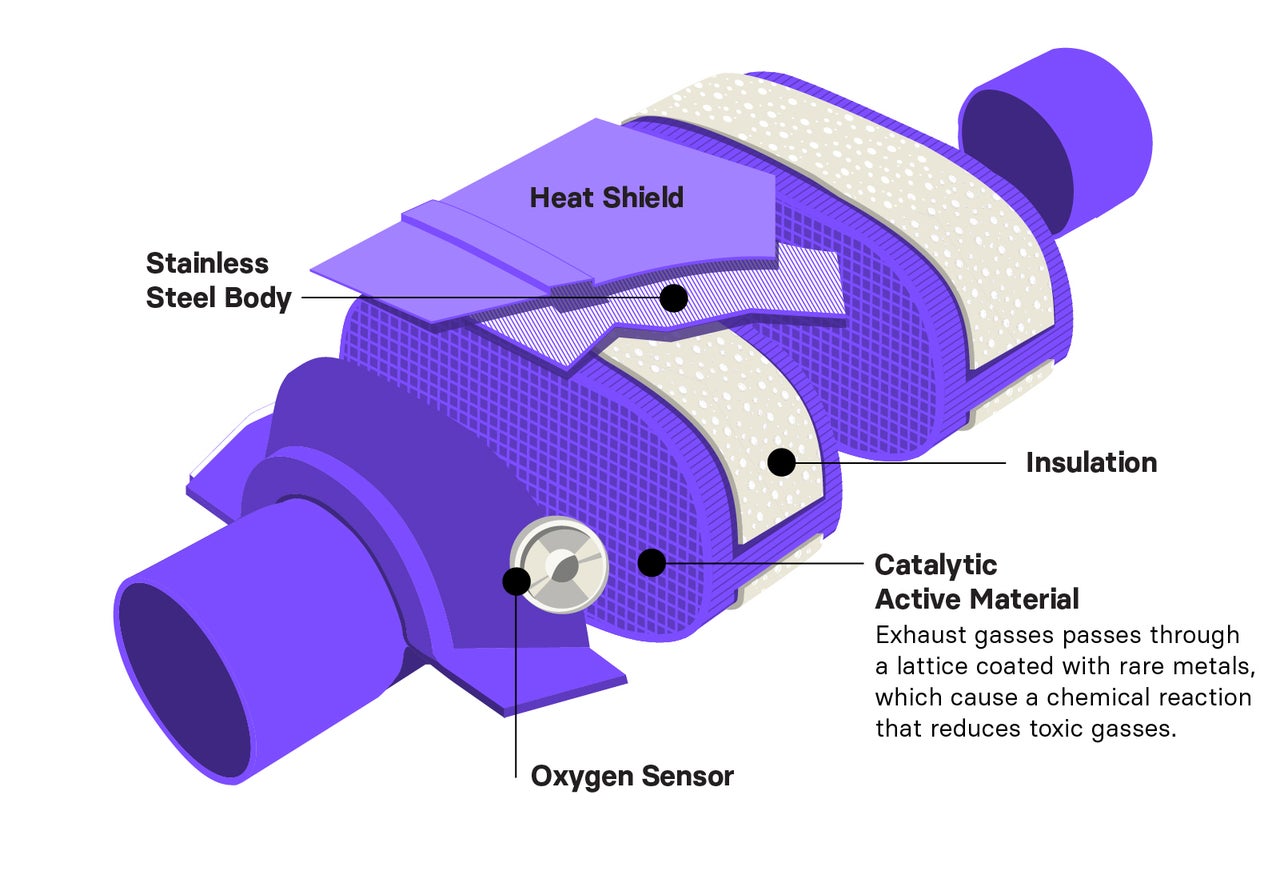
“If gold mining ceased tomorrow, the gold supply would last 25 years at most,” a Canada-based mineral exploration company, Palladium One Mining, states on its website. “But if the same was done for palladium, the supply would last maybe a year or two. The limited supply of this precious metal gives investors significant opportunity for profit.”
By February 2020 an ounce of palladium was worth $2,600. That same month, Navin Khanna, 39, founded the auto company DG Auto Parts LLC in an industrial park in Monmouth County, New Jersey, a suburban pocket of colonial-style townships along the state’s Atlantic shore. (The Khannas and their lawyers didn’t respond to interview requests.)
He ran the business with his 35-year-old brother, Tinu. Born in India, they were in the first generation of their family to come of age in the US. Their older brothers owned a junkyard, and after a few years working there in their early 20s, Navin and Tinu branched out on their own: rubber disposal in 2016, recycling in 2018, auto wrecking and commodities trading in 2019. None of their endeavors worked out until DG Auto, according to an interview Navin gave to ACE Finance for a loan application aimed at expanding the company.
DG Auto occupied a critical role in the catalytic converter trade: buying the part, extracting the palladium, and selling the mineral. “Get the most money for your catalytic converters,” read one banner on its website. “We offer some of the highest prices for your converters.”
To ensure a fair trade amid the market’s fluctuations, DG Auto operated an app where prospective sellers — for a subscription fee — could see real-time prices on the company’s “proprietary pricing tool” and lock in a rate before shipping the converters. Once the goods arrived in the New Jersey auto shop, they underwent a de-canning process: a guillotine powered by a hydraulic press chopped open the converters, and the core’s powdery gray contents spilled into a machine that separated out the valuable metals.
In the loan application interview, Navin explained that DG Auto took off once he connected with a company looking to buy the metals extracted from converters. That company, Dowa Metals and Mining America, processed the material at its refinery in Burlington, New Jersey, 20 miles north of Philadelphia.
Dowa was willing to buy as much palladium as DG could sell, according to court documents. The Khanna brothers opened a DG Auto South branch in Virginia and partnered with a shop in Wisconsin. DG Auto sourced products from a nationwide network of vendors. An auto shop in Tulsa, Oklahoma, provided converters mostly from trucks, including Ford F-250s, Toyota Tundras, and Toyota Tacomas. For access to the most valuable converters, from mid-2000s Priuses, DG Auto looked further west.
On September 10, 2020, according to court documents, Navin Khanna sent a Facebook message to Choy Saeteurn, a 37-year-old mechanic from south Sacramento: “I need more Prius lol.”
“Where your boy at Tou?” Saeteurn replied.
“Dang,” Khanna wrote. “He shipped me 300 sets today.”
A week earlier, on Sept. 3, Saeteurn had received a message from Tou Vang, the auto shop entrepreneur from the friendly family on Meadowgate Drive: “You back yay! <3”
Saeteurn: “Back where?”
Vang: “Buying lol”
Saeteurn: “One step at a time Not touching tho”
Vang: “Yeah just you know be careful I’m still buying but very dl very dl”
Saeteurn: “Yeah imma just stay on the dl”
By then, law enforcement agents were already monitoring Saeteurn’s Facebook messages. In August, investigators had obtained a search warrant for a cellphone “associated with a known cutter,” and that phone showed the “known cutter” discussing catalytic converters with Saeteurn, whose Facebook account was the target of the next search warrant. Saeteurn declined an interview request, but told BuzzFeed News that he was “just a worker.” He has not been charged in the case.
In court documents, prosecutors would allege that Vang was purchasing catalytic converters “‘on the down low’ or discreetly … because of his May 2019 arrest for stealing catalytic converters.”
Vang had opened Vang Auto Core LLC on May 2, 2019, and then on May 31 was arrested on charges of grand theft for allegedly stealing a converter from a red Prius. He didn’t show up for a court date and had a bench warrant out on him, according to prosecutors. It wasn’t his first arrest. Three years earlier, he’d been charged with identity theft and burglarizing a series of department stores in a case that was ultimately dismissed.
By September 2020, Vang had been swept into a multistate investigation that discovered the scale of his profits, according to prosecutors. Bank records showed his first known transaction with Khanna taking place on Oct. 1, 2019. Over the next three months, Vang made 46 ATM withdrawals of exactly $10,000 across five separate banks, spent a $29,000 cashier’s check on a Toyota Highlander, and bought his mother a $34,000 Toyota Rav4, according to court documents. A few months after that, he paid $65,000 cash on a Toyota Tundra for his brother.
On Sept. 11, 2020, a day after Khanna told Saeteurn that Vang had sent him 300 Prius converters, bank records showed DG Auto wiring $400,000 to Vang Auto. The following April, shipping manifests showed Vang Auto sending two crates, weighing a combined 4,370 pounds, to DG Auto. Over the next two weeks, DG Auto wired Vang Auto $975,000.
By May, according to court documents, authorities had a confidential informant selling converters to Vang. The transactions would take place at the Vang family’s house on Meadowgate Drive. The informant made five separate sales to Vang Auto from May to August 2021, usually two or three at a time, with Prius converters going for up to $1,200 each.
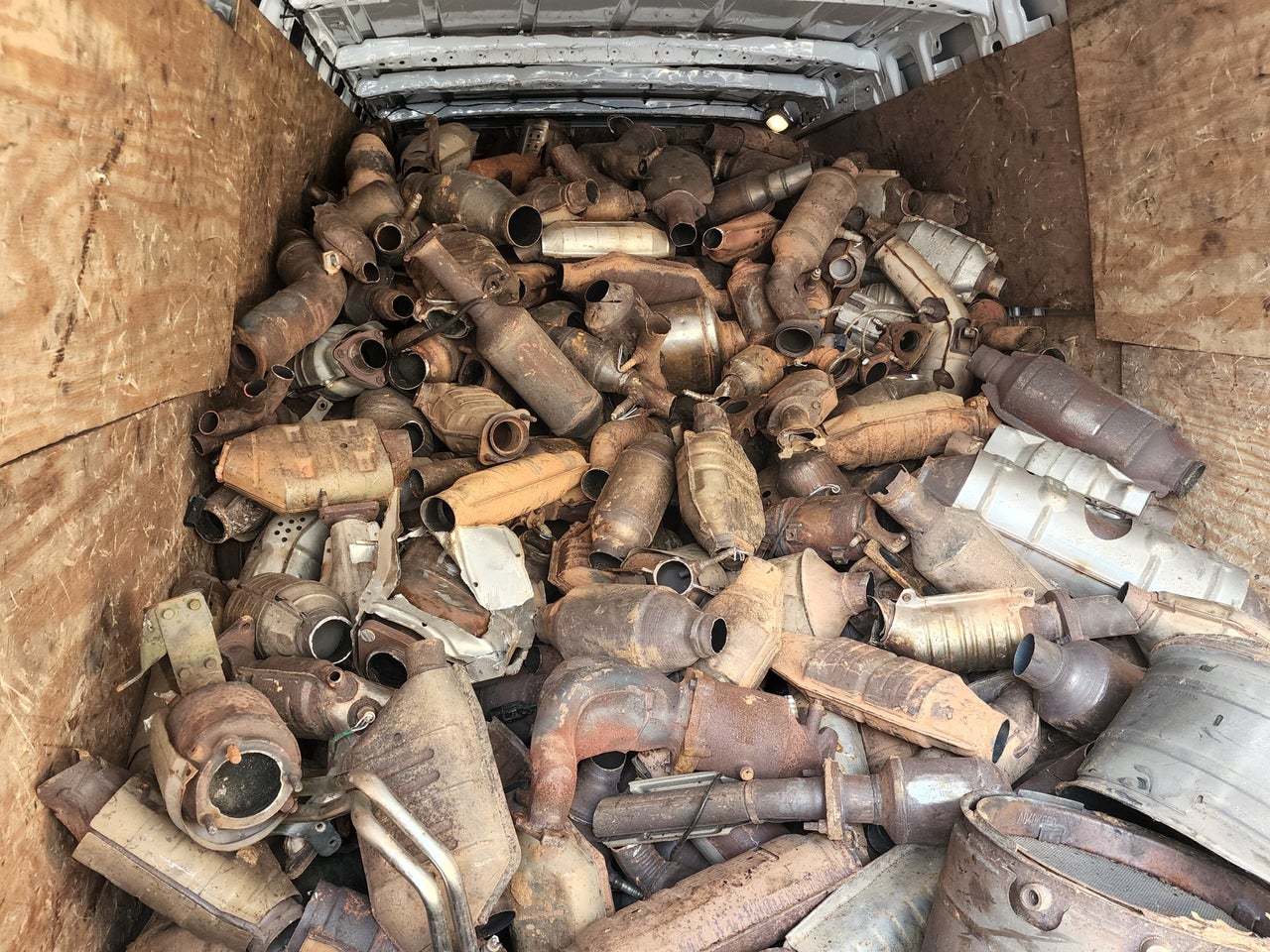
Authorities claim that stolen catalytic converters are easy to spot because they are cut more roughly at the edges than ones detached in professional salvage yards, where the process isn’t rushed. A buyer who doesn’t ask questions, though, can still deny any knowledge that the product was stolen, and an investigator examining a pile of converters would have no way to confirm whether any had been obtained illegally. Advocates for stricter laws regulating converters argue that the best way to diminish the market for cutters is to target buyers by prohibiting possession of a converter without paperwork tracing the chain of ownership — policies that have been implemented in some states over the last two years. Short of those requirements, investigators seek evidence indicating a person knows they’re buying stolen goods.
During one of the sales to Vang Auto, according to court documents, the informant mentioned that he “stole” a converter from a Prius he’d hit before. “For future reference,” Andrew Vang replied, “don’t say they were stolen.”
To its clients, DG Auto seemed to have a limitless appetite for catalytic converters.
“Khanna does not care where the catalytic converters come from,” Marty Macerauskas, a Texas-based auto shop owner who sold parts to DG Auto, told investigators, according to court documents, “only that he wants the volume so he can keep up with sales to Dowa.”
Dowa Metals and Mining America, Navin Khanna said in his loan application, was “trying to get into the market” for catalytic converter minerals.
While Khanna knew the company as a New Jersey–based refinery a few counties over, its history traces back more than a century and half a world away, to 1884 in Japan’s Akita prefecture, the mountainous region where Dowa first began its mining operations.
The company specialized in kuroko ore, black volcanic deposits that can contain copper, lead, zinc, silver, and gold. Dowa acquired more mines around the country in the early 20th century, then began exploring international territory in the decades after World War II. By the end of the century, its domestic operations had wound down “due to economic changes and the depletion of ore,” according to its website. It established mines in Mexico and Canada as its business came to operate entirely overseas.
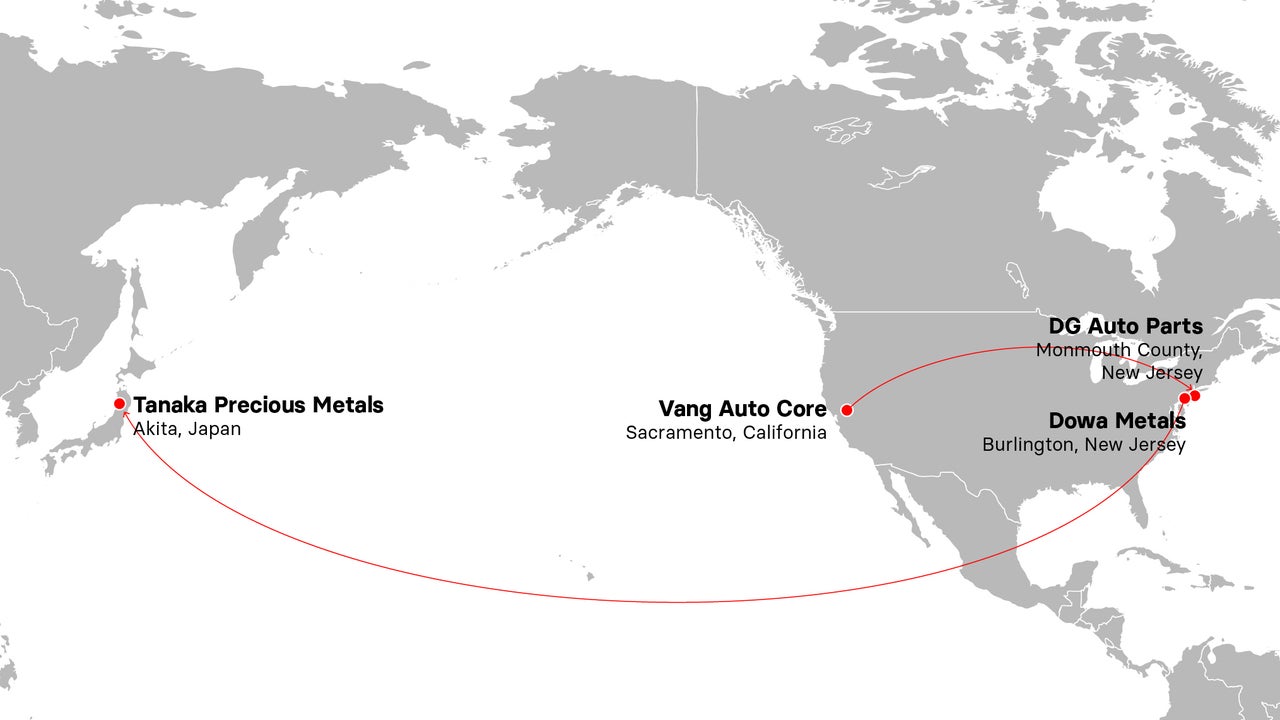
In 1991, three years before it closed its last mine in Japan, Dowa formed a partnership with Tanaka Precious Metals, a metal supplier also based in Akita, to form a corporation based in New Jersey, Nippon PGM, a refinery specializing in recycling metal from U.S. sources. One of Nippon’s subsidiaries is Dowa Metals and Mining America.
Once Dowa Metals and Mining America received metal from DG Auto, its refinery in Burlington, New Jersey, processed the material into chunks that shined like new, bearing no indication of its origins. Dowa then shipped those metals to Akita, where Tanaka Precious Metals prepared them for sale.
Founded in 1885 as a money exchange, Tanaka had transformed over the decades into one of the world’s preeminent metal suppliers, providing critical materials to many of Japan’s car, computer, and electronic manufacturers. From 2018 to 2022, Tanaka’s annual revenue rose by around 20%, to $288 million. (Dowa and Tanaka did not respond to requests to comment on the case.)
One of Tanaka’s clients is Toyota. It is entirely possible that the palladium pilfered in California, refined in New Jersey, and repurposed in Japan has ended up inside catalytic converters installed on Priuses shipped across the Pacific.
Bank records, presented in court documents by prosecutors, offer a glimpse into the fruits of a newfound cashflow, most visible in the purchases of young men with a passion for automobiles.
On Dec. 17, 2020, Tinu Khanna spent $200,000 on a Lamborghini.
On Dec. 18, 2020, Navin Khanna bought his wife a $240,000 Mercedes-Benz.
That same day, Tou Vang paid $423,000 in cash for a four-bedroom, 1,590-square-foot house in south Sacramento, not far from the family’s home on Meadowgate Drive, where they continued to live.
In May 2021, Tinu bought a $443,000 Ferrari and an $18,000 Rolex, and traded in his Tesla along with $80,000 for a Porsche Cayman. That same month, Navin traded in his 2020 McLaren plus $260,000 for a new model, priced at $550,000. The new car’s vanity license plate read “GD3 EA6,” the parts code for catalytic converters from Toyota Priuses manufactured between 2004 and 2009.
In August and September 2021, Tou bought two Teslas for a combined $205,000.
According to prosecutors, the catalytic converter trade ushered the Vangs into a state of financial stability countless families across the country could only dream of. By their calculation, perhaps, it was an outcome worth risking freedom for.
Tou had been careful to keep cash withdrawals to $10,000 or less, presumably in an effort to avoid triggering a law requiring banks to disclose larger amounts to the IRS. After purchasing two converters in August 2021, Andrew asked the vendor to “see if you can cover it better” the next time they brought goods to the house, because another vendor had recently “brought hella heat over here” by driving over in a stolen car, according to court documents. The vendor Andrew was talking to was a confidential informant wearing a recording device.
For the Vangs, though, prison wasn’t the only threat. They were doing business out of their own home on Meadowgate Drive. According to law enforcement, “many of the thieves that sold catalytic converters” to the Vang family had ties to the Tiny Raskal Gang, a group founded in Long Beach in the 1980s by newly arriving Cambodian refugees who sought protection against neighboring gangs, before eventually emerging on the FBI’s radar after a series of violent incidents. The Vangs kept at least five guns in their house, as well as more than 1,300 rounds of ammunition.
“By summer 2022, the Vangs and Khannas had earned more money in a few years than some families attain in decades.”
So when a burglar broke into the house in November 2021, investigators speculated that the culprit “seemingly knew” about the family’s lucrative business, according to court documents. Prosecutors alleged at a hearing that the attempted robbery took place while Monica “was purchasing stolen catalytic converters.” Andrew Vang wasn’t charged for the shooting, which was determined to have been in self-defense. The police raid that, in the words of neighbor Joe McElroy, “destroyed” the house didn’t lead to any arrests.
When the Vangs left the house on Meadowgate Drive, they may have still carried the belief that they were in the clear. They turned to their business partners out east to help facilitate their move. In December 2021, according to property records, the Khanna brothers paid $1.2 million for a house in northern Sacramento on behalf of the Vangs.
By summer 2022, the Vangs and Khannas had earned more money in a few years than some families attain in decades. Their cars and homes were paid off. Their loved ones were comfortable. Even without the Meadowgate property, the Vangs’ two remaining Sacramento houses offered plenty of space for extended family.
While the Khannas didn’t deal directly with cutters, investigators building a case against them unearthed evidence suggesting that Navin had a sense of how his vendors were sourcing the goods. In one Facebook message cited in court documents, he wrote, “every cat in Cali [is] stolen I can promise you that.” One vendor, who turned out to be a confidential informant wearing a wire, claimed to have access to a Prius warehouse in Southern California, where they could obtain catalytic converters, as well as the original “bricks” of metals that get placed inside of them. For $259,000, DG Auto bought 402 bricks and 98 catalytic converters, according to court documents.
Navin seemed aware of the heightening risks his business faced as law enforcement agencies began cracking down on the catalytic converter trade. In a call with an employee that was recorded on Aug. 5, 2022, Khanna advised his team against “traveling with cash” because authorities were “busting everybody.”
But despite that concern, business was going smoothly enough that on Aug. 15, 2022, Khanna applied for a loan to buy a salvage yard. Four days later, he bought a Rolls-Royce for $220,000 and posted a photo of it with a champagne bottle on Instagram. A couple of weeks after that, he drove that car to meet with two people who were selling catalytic converters. They were actually undercover cops.
By spring 2022, investigators had already suspected DG Auto was a major hub for a nationwide black market. The case, which spanned local and federal agencies, carried the codename Operation Heavy Metal.
On May 10, 2022, 21-year-old Kristina Macerauskas arrived at a New Jersey home owned by the Khanna brothers’ parents. She left with a garbage bag filled with cash and drove back toward Clarendon, Texas, where she and her husband, Marty Macerauskas, 28, owned an auto body shop called M&M Auto. Before she arrived, she was pulled over. Officers found more than $1 million cash in the bag. A search of the M&M Auto shop turned up 30 converters.
In interviews with investigators, Kristina and Marty revealed details about their business dealings, acknowledging their role as a mid-level fencer in the market — an “intermediate buyer” in law enforcement terminology. Kristina estimated that around a quarter of the people they “buy from are selling stolen catalytic converters,” mostly from Toyota Tundras, according to court documents. Both said that they were selling those catalytic converters to DG Auto.
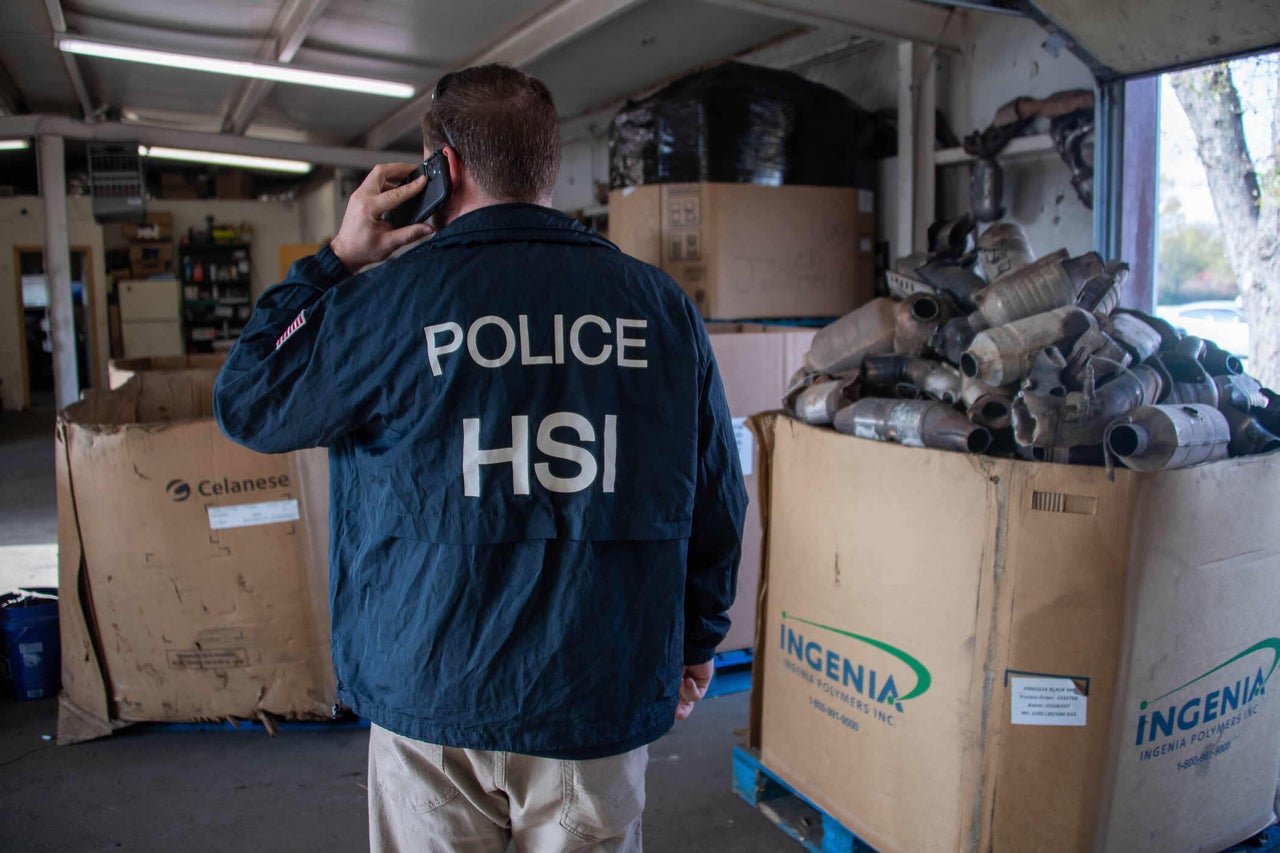
Kristina claimed that Khanna took control of regional markets in Texas and Oklahoma. She told investigators that “if an intermediate buyer does not want to work with Khanna, Khanna will send another buyer into the area and overpay other suppliers to put the person out of business.” Meanwhile, the vendors who built a relationship with Khanna gained certain benefits as business partners. Khanna fronted money to help them buy as many converters as possible, prosecutors said. Some partners, including Marty Macerauskas, had administrative access to DG Auto’s app, which allowed them to adjust the rates they paid to lower-level sellers.
According to the Macerauskases, M&M Auto was part of an interwoven network of catalytic converter merchants organizing shipments between the middle of the country and the East Coast. Sometimes these vendors collaborated to consolidate shipping and payments.
One auto shop M&M worked with was Curtis Cores, which was based in a salvage yard just outside Tulsa, Oklahoma. Its owner, Tyler James Curtis, 26, had been on law enforcement’s radar since February 2021, when he posted a Facebook Marketplace ad seeking catalytic converters. Investigators using a fake Facebook profile messaged him, “how much do you buy and does it matter where they came from…” Curtis responded, “I buy as many as you got and no.”
Three months later, Tulsa police arrested Curtis. At his yard, officers found 128 “suspected stolen” catalytic converters, as well as 3 grams of cocaine and 8 grams of heroin, according to court documents. With a search warrant for his iPhone and iPad, investigators found a Facebook message group that included Curtis, Navin Khanna, and another partner, Adam Sharkey, who operated Capital Cores, an auto body shop in Long Island, New York, that often served as a facilitator between the Oklahoma and New Jersey businesses, prosecutors allege. Curtis and Sharkey didn’t respond to interview requests for this story. Through their lawyer, Kristina and Marty Macerauskas declined to comment.
Even after Curtis’s arrest, bank records showed a regular flow of payments from DG Auto to Curtis Cores.
Then, in April 2022, an off-duty sheriff deputy in Houston was fatally shot in a grocery store parking lot by a cutter he caught trying to steal the converter from his vehicle. An investigation into that incident led agents to a local gang that delivered converters to Curtis Cores in a U-Haul trailer. Police interviewed one of the gang’s alleged leaders, who told them that Curtis instructed him on what car models to hit.
Over the following months, law enforcement agents unleashed a series of arrests, raids, and searches targeting every branch of the network they could find, in California, Nevada, Wyoming, Minnesota, Oklahoma, North Carolina, Virginia, New Jersey, and New York. Employees of Curtis Cores and Capital Cores were pulled over while transporting cash. Some cooperated with investigators, strengthening the case against the Khannas and their higher-level partners.
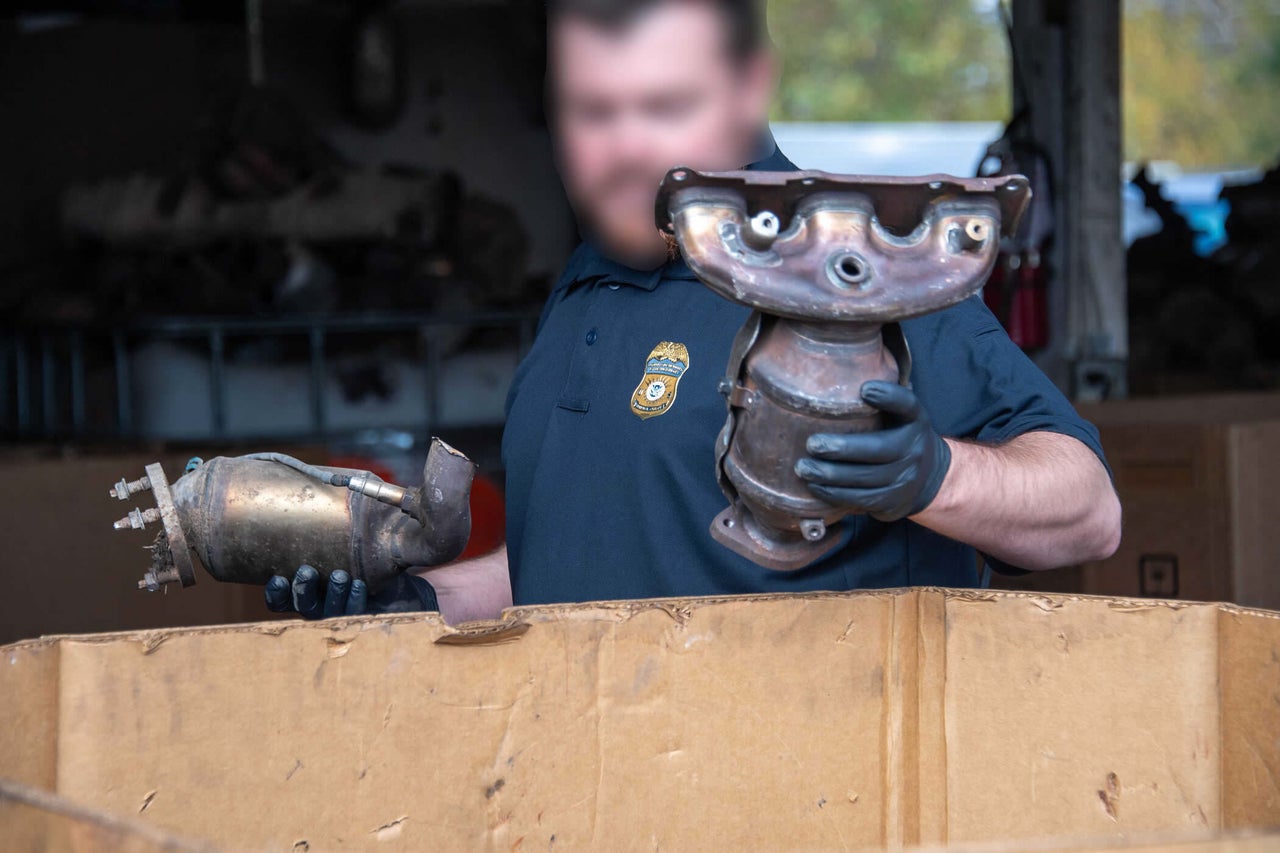
In October, federal prosecutors in California and Oklahoma issued indictments against 21 people tied to the network. Law enforcement agents seized cars and cash they alleged to be profits of an illicit enterprise. The Khanna and Vang brothers face charges of conspiracies to launder money and transport stolen goods across state lines. Based on the counts against them, Navin faces up to 65 years in prison, Tou 55 years, and Tinu and Andrew 25 years. Monica Moua was also charged as an alleged participant in the conspiracy, accused of being present for some of the transactions on Meadowgate Drive, and faces up to 15 years in prison. While Monica and the Khanna brothers were able to make bail, Tou and Andrew were denied release in part because, the judge said, Tou had previously skipped out on a court hearing for his 2019 theft charge with Andrew’s help. They are currently in separate jails awaiting trial, which has yet to be scheduled. As part of her bond conditions, Monica isn’t permitted to speak with her sons.
Court documents, citing bank records, show the network’s financial scale.
Over at least two years, DG Auto paid around $6 million to M&M Auto, $13 million to Curtis Cores, and $45 million to Capital Cores.
From October 2019 to October 2022, Vang Auto sold $38 million worth of converters to DG Auto. Over that span, DG Auto received $545 million from Dowa Metals and Mining America.
In the case against the Vangs, prosecutors said in court that of the $25 million “in cash that has been withdrawn” from their bank accounts in recent years, only $150,000 was recovered by law enforcement, part of their argument that the brothers might have enough money to flee the country if released on bail.
In the case against the Khannas, prosecutors said that $26 million in withdrawals from their bank accounts remained unaccounted for. Khanna’s lawyer said in court that the discrepancy was due to mislabeled invoices, and that the amount was an overestimation that didn’t account for business expenses. Prosecutors claimed, in a motion, that the missing cash is evidence that “not all of his assets have been seized.”
Crime trends bloom in a window that can shut at any moment. For decades, car thefts had been a mass menace, until new key designs and GPS capabilities made the risk outweigh the payoff — in New York City, for instance, the number of car thefts dropped from around 147,000 in 1990 to around 10,000 in 2010, while the national rate decreased by around 64%. To those calling for stricter laws, new regulations on the catalytic converter trade might similarly ward off the opportunists who benefit from the palladium boom, recalibrating the calculus measuring risk against reward even as the economic conditions that spur some people to steal remain unchanged.
On a recent afternoon in Sacramento, I knocked on the door of one of the properties linked to the Vangs. A young woman answered and explained that the family was declining to comment while the case was pending. Beside her stood a man who looked to be in his sixties and a young woman holding a baby. The names of their relatives had been broadcasted in news articles and Department of Justice press releases proclaiming a major crackdown on a high-profile crime trend. But behind those names are loved ones left behind to navigate the aftermath. In the front yard, several children ran around, laughing and playing.
Albert Samaha is a senior culture reporter at BuzzFeed News and author of two books, “Concepcion: Conquest, Colonialism, and an Immigrant Family’s Fate” and “Never Ran, Never Will: Boyhood and Football in a Changing American Inner City.” He is based in New York. Contact Albert Samaha at albertconcepcionsamaha@gmail.com.
